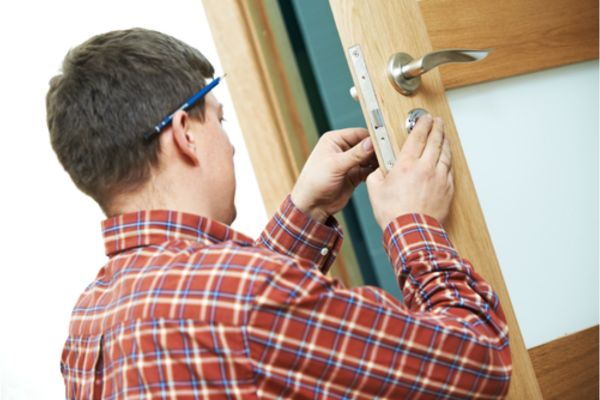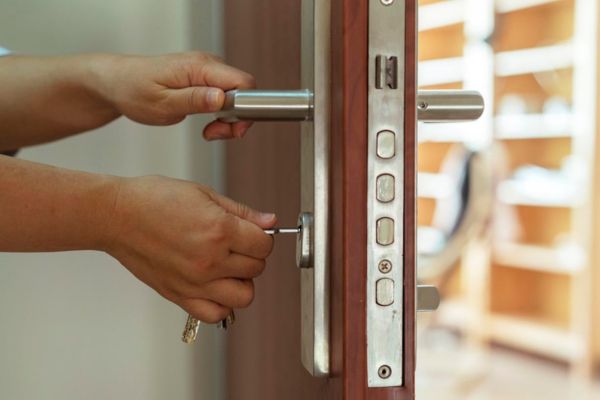In our daily lives, locks are vital for protecting our homes and possessions. Whether it’s the front door of our house, a lock on a treasured chest, or a padlock on a garden shed, locks serve as our primary defense against burglars and guardians of our privacy. However, like any other mechanical device, locks can wear down and become less effective over time. That’s why understanding how to extend the lifespan of your locks is important for making sure the security and functionality of your property. In this comprehensive Lock Maintenance Guide, we will explore some simple steps and practices that can help make your locks last longer, saving you both time and money in the long run. So, let’s dive into the world of lock maintenance and discover how you can keep your locks in tip-top shape for years to come.
Routine Cleaning and Maintenance
Furthermore, consistent cleaning and maintenance are essential for ensuring the dependability of your locks. As time goes by, dirt, dust, and debris can gather in the keyway and lock mechanism, hindering the smooth operation of your locks. Therefore, it’s crucial to adhere to a simple routine to keep your locks clean and functional, as explained in our Lock Maintenance Guide:
Gentle Cleaning:
Start by using a gentle brush, such as a toothbrush, to remove loose dirt and debris from the keyhole and the area around it. Be careful not to push any particles deeper into the lock.
Cleaning Solution:
Additionally, if you encounter stubborn grime or residue, you can address it effectively by creating a mild cleaning solution. Simply mix water with a small amount of dish soap. Then, dampen a cotton swab or cloth with this solution and gently clean the keyhole and the outside of the lock. This method can help ensure your locks stay clean and in optimal working condition.
Drying:
After cleaning, ensure that the lock is completely dry. You can use a blow dryer on a low, cool setting to speed up the drying process.
Graphite Lubricant:
Once the lock is clean and dry, apply a small amount of graphite lubricant to the key and insert it into the lock. Turn the key back and forth a few times to distribute the lubricant evenly within the lock.
Check for Smooth Operation:
Test the lock with the key to ensure it turns smoothly. If you come across any resistance or rigidity, reapply lubricant and test again.
Annual Maintenance:
Perform this cleaning and lubrication routine at least once a year for optimal lock performance. If your locks are exposed to harsh environmental conditions, such as saltwater or extreme humidity, consider more regular upkeep.
By incorporating regular cleaning and maintenance into your routine, you can prevent dirt and debris buildup that can cause lock problems and ensure that your locks remain in good working order. These simple steps can significantly extend the lifespan of your locks and contribute to your overall home security.
Proper Lubrication Techniques
Proper lubrication is essential to maintain the functionality of your locks. Here’s a guide on how to lubricate your locks effectively:
Choose the Right Lubricant: Use a high-quality lock-specific lubricant, such as graphite powder or silicone-based spray, as recommended in our Lock Maintenance Guide. Avoid using oil-based lubricants like WD-40, as they can attract dust and debris, leading to lock problems.
Prepare the Lock:
Before applying lubricant, make sure the lock is clean and free of dirt and debris. If needed, follow the cleaning steps mentioned earlier in this article.
Insert the Key:
Insert your key into the lock and turn it a few times to distribute any remaining dirt or residue.
Apply the Lubricant:
For graphite lubricant: Insert the nozzle of the graphite tube into the keyhole and squeeze a small amount of graphite powder inside. For spray lubricants: Insert the nozzle into the keyhole and spray a short burst of lubricant. Avoid over-applying, as excess lubricant can attract dirt.
Work the Key:
Insert and remove the key several times to ensure the lubricant spreads evenly throughout the lock mechanism. Turn the key to engage all the internal parts.
Wipe Excess Lubricant:
Use a clean, lint-free cloth to wipe away any excess lubricant on the lock’s exterior. Excess lubricant can attract dust and dirt.
Test the Lock:
After lubricating, test the lock to ensure it operates smoothly and without any resistance. If you encounter any issues, reapply a small amount of lubricant and test again.
Repeat as Needed:
Based on how often you use your locks and the surrounding environment, it’s a good idea to apply lubrication once a year or whenever you notice your locks becoming stiff or the key is hard to turn.
Proper lubrication not only extends the life of your locks but also ensures their reliable performance, as highlighted in our Lock Maintenance Guide. Regular maintenance helps prevent lock malfunctions, making your home more secure and your daily life more convenient.
Key Care Practices
Taking care of your keys is essential to ensure they remain functional and reliable. Here are some key care practices to keep in mind:
Designate a Safe Location:
Designate a specific spot in your home where you’ll keep your keys. This can be a key rack, a drawer, or a key bowl. Having a designated spot reduces the chances of misplacing your keys.
Use Keychains:
Keychains not only add a personal touch but also make keys easier to identify. Choose keychains that are durable and securely attach to your keys to prevent them from falling off.
Avoid Overloading:
Don’t overload your keyring with too many keys or heavy keychains. The added weight can put stress on your locks and may lead to premature wear.
Regularly Check for Damage:
In addition, it’s advisable to periodically inspect your keys for signs of wear or damage. Pay close attention to any keys that appear bent or cracked, as using such keys can potentially harm your locks. If you happen to identify any issues with your keys, it’s a prudent course of action to consider obtaining a replacement key promptly. This proactive approach helps maintain the security and functionality of your locks.
Keep Keys Clean:
Moreover, to maintain the effectiveness of your keys, it’s crucial to keep them clean and free from dirt, grime, and debris. This can be accomplished by using a soft brush or compressed air to carefully remove any accumulated dirt from the key’s crevices. This simple practice can go a long way in ensuring your keys remain in excellent working condition.
Handle with Care:
Be gentle when handling your keys. Avoid using excessive force when inserting them into locks, as this can damage both the key and the lock.
Use a Key Organizer:
Consider using a key organizer, which can help you keep your keys neatly organized and prevent them from jingling in your pocket or bag.
Duplicate Keys Sparingly:
While having spare keys is convenient, try not to create too many duplicates. The more keys you have floating around, the higher the chances of losing or misplacing them.
Label Keys:
Additionally, if you have several keys that look similar, it’s a sensible approach to use labels or colored keycaps to tell them apart. This method helps you quickly identify the right key for the corresponding lock, making things more convenient and reducing the chances of mix-ups or confusion.
Securely Store Spare Keys:
If you have spare keys, store them in a secure and discreet location. Avoid leaving spare keys under doormats, plant pots, or other common hiding spots, as these are known to burglars.
By following these key care practices, as outlined in our Lock Maintenance Guide, you can prolong the lifespan of your keys and reduce the chances of lock-related issues. Taking care of your keys is a small but essential aspect of home security and everyday convenience.
Regular Inspection for Wear and Tear
Regularly checking your locks for signs of wear and tear is a proactive way to make sure they continue to work well. Here’s how to do routine inspections effectively::
Visual Inspection:
Start by visually examining each lock on your doors. Look for any visible signs of wear, such as scratches, rust, or discoloration. Pay close attention to the keyholes and the locking mechanism.
Operational Check:
Test the lock’s operation. Insert the key and turn it to ensure smooth and effortless locking and unlocking. Check for any resistance or stiffness in the key’s movement.
Examine the Strike Plate:
Additionally, take a moment to inspect the strike plate on the door frame. Confirm that it aligns correctly with the lock’s latch. If you observe any visible marks or signs of damage on the strike plate, it’s important to consider making adjustments or replacing it as necessary. This attention to detail ensures that your lock operates smoothly and securely.
Test Door Alignment:
Sometimes, wear and tear on a door can affect how the lock functions. Test the door’s alignment by checking if it opens and closes smoothly. If the door sticks or doesn’t align properly, it can put stress on the lock.
Check for Loose Parts:
Gently wiggle the doorknob or handle to check for any loose or wobbly parts. Loose handles or knobs can affect the lock’s performance and should be tightened or replaced.
Inspect Key:
Examine the key for any signs of damage or bending. A damaged key can not only damage the lock but also make it difficult to operate.
Lubrication:
If you notice any stiffness or resistance when operating the lock, it may need lubrication. Apply a graphite or silicone-based lubricant to the keyhole and key to improve the lock’s performance.
Replace Worn Parts:
If you find any worn or damaged parts during your inspection, like a worn-out key or a faulty locking mechanism, it’s a good idea to replace them as soon as possible.
Consider Professional Inspection:
If you’re unsure about the condition of your locks or suspect hidden issues, consider hiring a professional locksmith for a comprehensive inspection and maintenance.
Regular inspections are useful for spotting potential issues early on, which lets you address them before they become more serious problems. By being proactive with your lock maintenance, you can guarantee the security and effectiveness of your locks for many years.
Environmental Considerations and Lock Protection
Locks are continuously exposed to various environmental factors that can impact how long they last. To make sure your locks endure and keep providing dependable security, it’s crucial, as stressed in our Lock Maintenance Guide, to think about these environmental factors and take actions to safeguard your locks.
Weatherproofing:
Weather can have an impact on locks, especially the ones on exterior doors. Extreme temperatures, humidity, rain, and snow can make locks rust or become difficult to use. To safeguard your locks, think about adding weatherproofing measures like door sweeps, threshold seals, or weatherstripping. These safeguards can help shield your locks from the effects of the weather.
Salt and Corrosion:
If you live in an area where road salt is used during the winter months, your locks may be exposed to corrosive salt residue. Over time, this can lead to rust and damage. To combat this, rinse your locks and keys with fresh water regularly during the winter and keep them lubricated to prevent rust formation.
Dust and Debris:
In addition, dust, dirt, and debris can accumulate both inside and around locks, potentially causing malfunctions. To prevent this issue, it’s essential to routinely clean your locks. You can achieve this by using a soft brush or compressed air to remove particles that might hinder their performance.
UV Exposure:
Moreover, sunlight can lead to the gradual degradation of plastic and rubber components in locks. If your locks are exposed to direct sunlight, it’s worth considering the use of UV-resistant coatings or covers to shield them from this damaging effect.
Moisture Control:
Furthermore, moisture can seep into lock mechanisms, potentially causing internal rust or freezing in cold weather. To prevent this, it’s advisable to use a moisture-displacing lubricant regularly to keep your locks dry and functioning smoothly.
Insect and Pest Control:
Additionally, insects and pests can sometimes find their way into lock mechanisms, obstructing their operation. Therefore, it’s essential to regularly inspect and clean your locks to ensure there are no unwanted guests causing problems.
Lock Covers:
Consider using lock covers or shields, especially for outdoor locks. These covers can offer an additional layer of protection against environmental factors and potential tampering.
By addressing these environmental considerations and taking proactive measures to protect your locks, you can significantly extend their lifespan and maintain the security of your home or property.
Avoiding Forceful Actions
One of the most common mistakes that can lead to lock damage, as cautioned in our Lock Maintenance Guide, is attempting to force a stubborn lock open. Whether due to a jammed key or a frozen lock in cold weather, forcing a lock can result in costly repairs and compromise your security. Instead of applying excessive force, consider these alternative approaches:
Use Lubrication:
If a key doesn’t turn smoothly, avoid using brute force. Apply a lock lubricant to the keyway, and gently jiggle the key while turning it. This can help loosen internal components and make it easier to unlock.
Check the Key:
Examine the key for any visible damage or bends. If you notice issues with the key, don’t force it. Instead, use a spare key or seek professional assistance.
Warm the Lock:
In cold weather, locks can freeze. Instead of forcing the key, use a hair dryer or a de-icer to gently thaw the lock. Avoid pouring hot water, as it can refreeze and cause further problems.
Contact a Locksmith:
If you encounter persistent issues with a lock, it’s best to consult a professional locksmith. They have the expertise and tools necessary to diagnose and resolve lock problems without causing additional damage. This way, you can ensure the effectiveness and longevity of your locks while avoiding unnecessary complications.
Avoid Lock Bumping:
Moreover, it’s important to mention that some people may try lock bumping techniques to forcefully open locks. However, it’s crucial to understand that these methods can seriously harm the lock and may not be a wise choice. Therefore, it’s a good practice always to prioritize non-destructive methods when dealing with lock-related issues, as explained in our Lock Maintenance Guide. This approach helps ensure your locks last longer and remain functional without causing undue harm.
Preventative Maintenance:
Regularly maintaining your locks, including cleaning and lubricating them, can prevent many issues that might lead to the temptation to use force.
In summary, avoid applying force to locks when they are not functioning correctly. Using patience and non-destructive methods can save you from costly lock replacements and ensure the continued security of your property.
Upgrading Locks When Needed
Lock technology is continually advancing to provide better security. Therefore, if your locks are outdated or showing signs of wear and tear, it’s prudent to consider upgrading to more secure options. This proactive approach can enhance your home’s security and extend the lifespan of your locks.
Seeking Professional Maintenance
Expert locksmiths provide maintenance services that can greatly prolong the life of your locks. Routine inspections, cleaning, lubrication, and adjustments carried out by a skilled locksmith can keep your locks in excellent condition. Don’t hesitate to seek professional help when required.
Conclusion
Taking simple yet effective steps to care for your locks can go a long way in prolonging their lifespan. Regular maintenance, gentle handling, and timely upgrades when necessary will not only save you money in the long run but also ensure the security of your home or property. By following these practices, you can enjoy the peace of mind that comes with reliable and durable locks.







